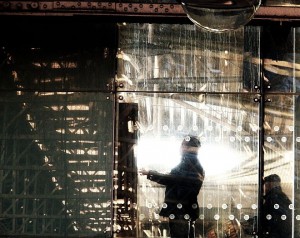From the New York Times Op-Ed. April 11, 2119, by Arlene Morris. Provided by Adam Aresty
Photography by Eleanor Leonne Bennett
When the info-cube landed in Sydney, the whole world was watching. The Japanese picked it up on their long-range sensors, then the Koreans, then the United States, then everybody else. We knew it was coming, and we knew where it was going to land. What we did not know was how it would change the world we lived in forever.
But this isn’t about the info-cube–that craft the size of a warehouse, geometrically perfect in every way we could measure. This isn’t about the wonders of technology that were gifted unto the human race when its east wall lowered, bathing Sydney Harbor in blue light, inviting any and all to share in the previously unknown knowledge of the universe. This isn’t about the quantum enlightenment that spread around the globe at a pace we could barely keep up with. We cured much of what ailed our planet. Hunger, poverty, pestilence–all forgotten. The cube brought with it a sense of giddy wonder at first, shared by yours truly, but that wonder faded once we had unlocked its knowledge-drive and begun to build the teleportation hubs that would eventually allow us to be anywhere, anytime. No, instead, this is about one man and the complicated choice he made leading up to January 19th, 2119. As the world watched the info-cube close its east wall and float away through the sky, we all wondered who had given themselves to that empty center chamber. More importantly–we all wondered why?

Who built the cube? What did its knowledge mean to these thousands upon thousands of species? These are questions I wondered myself, and I can only imagine Jay had dozens more to ask–only the frustrating nature of the cube prevented us both from doing so.
To read the rest of this story, check out the Mad Scientist Journal: Autumn 2012 collection.
Arlene Morris is an author of technical manuals, and a contributing editor to The New York Times. She is currently working on a book about the history of nano space travel.
Adam Aresty is an award-winning screenwriter who lives in Los Angeles.
Eleanor Leonne Bennett is a 16 year old internationally award winning photographer and artist who has won first places with National Geographic, The World Photography Organisation, Nature’s Best Photography, Papworth Trust, Mencap, The Woodland trust and Postal Heritage. Her photography has been published in the Telegraph, The Guardian, BBC News Website and on the cover of books and magazines in the United States and Canada. Her art is globally exhibited, having shown work in London, Paris, Indonesia, Los Angeles, Florida, Washington, Scotland, Wales, Ireland, Canada, Spain, Germany, Japan, Australia and The Environmental Photographer of the Year Exhibition (2011) amongst many other locations.
Follow us online: